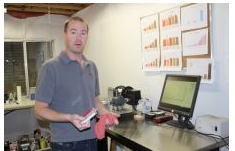
BOULDER, CO (BRAIN) — Visitors to Jason Smith's workshop — should they be far enough down the rabbit hole of bike geekdom to appreciate it — might be treated to a fairly eye-opening demonstration about bike chain friction.
Smith, a materials engineer and former multi-sport competitor, puts a brand new chain from a major manufacturer on a test rig that simulates a bike drivetrain being powered at 250 watts. That's the kind of power an amateur racer can maintain for an hour or so. The chain has been treated with a popular bike lube. While the drivetrain spins, a laptop screen shows the chain's friction resistance: it's costing the rider (or in this case a $5,500 electric motor) about 13 watts.
Then Smith mounts a different chain, also from a major manufacturer. This chain has been cleaned of its original lubricant and treated with a combination of paraffin wax and Teflon. The laptop screen shows another number: about 5 watts.
Many athletes spend months training to increase their power by 8 watts, or 3 percent. Smith showed that a choice in chain lube might allow the same improvement.
While the demonstration compared the best and worst chains and lubes in Smith's extensive testing, it used new, well-known products and common techniques, nothing extraordinary.
"This is not an uncommon set-up," Smith said. "A rider might set up his bike with the first chain and think he was doing everything right."
Smith has set up a cozy but well-equipped test lab in the basement of his house in an upscale neighborhood of North Boulder. He's spent the last few months measuring the friction in bike chains, derailleur pulleys and pedals.
It all started from his own mid-ride musings about the optimum components and lubes. Unlike most riders who have these kinds of thoughts, Smith had the engineering experience, training and resources to find the answers. The result is a small business called Friction Facts.
Via its website, Smith's company sells data reports on component friction to interested cyclists: a $9.95 package includes data on pedal, chain and pulley resistance. He also will treat chains with his special paraffin and Teflon process, selling treated new chains for roughly $20 more than retail.
He's also done special tests for Velo magazine, which will publish a chain lube comparison in its Buyer's Guide issue, coming out next month. If you want to know the details of the chain demonstration mentioned at the beginning of this article, you'll have to pick up that issue. Smith also is preparing to test another kind of product for Velo for publication next year.
Without revealing details of his reports or his testing for Velo, what's remarkable about Smith's test results is that component choices and lubrication procedures can make real, measurable differences, in some cases clearly large enough to determine the outcome of a close race.
Smith strives to maintain independence, something like a Consumer Reports lab. He buys all his tested products at retail, and buys test chains from multiple sources so they come from different manufacturing batches. He's avoided doing projects for specific manufacturers that might influence his objectivity.
Smith'd like to see the company outgrow his basement and expand its offerings. He's itching to test all the bearings on a bike and to keep providing his customers with updated data as he tests more products in more ways.
The potential market for $9.95 data reports is regrettably finite, but Friction Fact's limited marketing so far has generated enough cash flow to finance some new test equipment.
Smith is giving Friction Facts another six months to outgrow the basement, then he will decide whether to continue with the business full-time or scale back and take another engineering job — and perhaps ride his bike a bit more.
"I don't think anyone independent has ever tested this way before, so if I have to stop this after six months, at least I will have put this data out there for people to use," Smith said.





